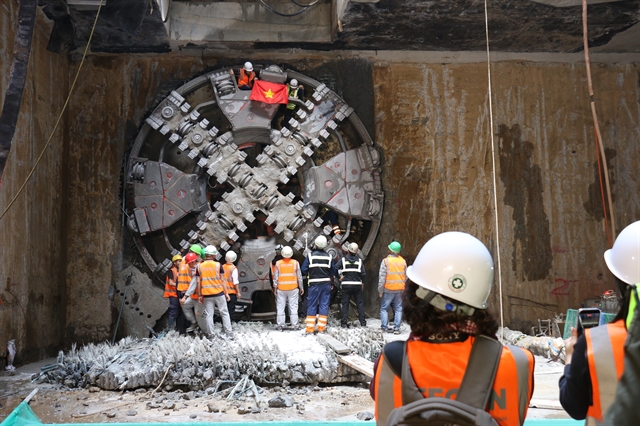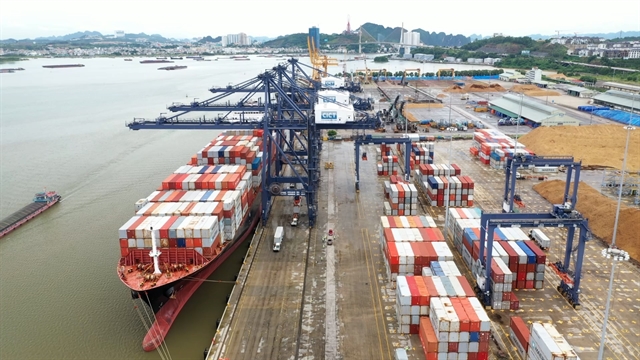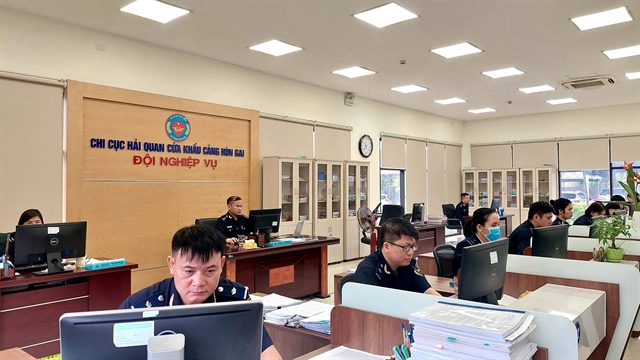 Economy
Economy

 |
| The ship SYNERGY BUSAN at Cái Lân international container port. VNA/VNS Photo |
QUẢNG NINH — Quảng Ninh Province promotes solutions to improve the quality of seaport services and prioritises the development of ports and wharves associated with logistics services.
Quảng Ninh's 250km long coastline with deepwater and wind protected areas offers favourable conditions for the construction and development of a seaport system, especially deep-water ports that can receive large ships, forming a large-scale centre of seaport services and logistics linking Việt Nam to the world.
With those potentials and advantages, in 2019, the province issued Resolution 15-NQ/TU on the development of seaports and seaport services in the province until 2025, toward 2030.
According to many economic experts, the Resolution has created a sustainable, targeted, specific development direction for the seaport, service and logistics sectors of Quảng Ninh in the context of international economic integration. It is also a motivation for the authorities, sectors and the business community to join hands in planning the development strategies.
According to the resolution, by 2025, total seaport service revenue of Quảng Ninh targets to reach VNĐ25 trillion (more than US$1 billion), an average growth of 17.5 per cent per year, contributing about 1.2 per cent-1.5 per cent of the province's GRDP.
The output of goods through the ports is targeted to reach about 114.5-122.5 million tonnes, the sea transport passenger number reaches 250,000-300,000 passengers.
To reach those goals, Quảng Ninh Province has proposed the Ministry of Transport add its 13 seaports with potential and advantages to the list of ports under the plan on development of Việt Nam's seaport system approved by the Ministry of Transport.
Up to now, all of these ports have been added to the master plan for developing Việt Nam's seaport system for the period 2021-2030 with a vision to 2050 approved by the Prime Minister in 2021, and the Quảng Ninh provincial master planning for the 2021-2030 period with a vision to 2050 approved by the Prime Minister in February 2023.
They include five seaports of Mũi Chùa, Vân Đồn, Vân Hòa, Vạn Ninh and Vạn Gia; Cô Tô Island district's port; four wharf areas of Cái Lân, Cẩm Phả, Yên Hưng and Hải Hà; Mong Cai ICD dry port and many floating wharves.
Quảng Ninh province has attracted many investors to put capital in the construction and development of ports and port services, including Hòn Gai international passenger port, Tuần Châu international passenger port, and Ao Tiên international port.
Quảng Ninh province now is calling for investment to develop the Con Ong - Hòn Nét port project in Cẩm Phả City and eight other projects of seaport services, production and processing, and manufacturing in the Quảng Yên coastal economic zone, with a total logistics area of about 7,000 hectares.
The Quảng Yên coastal economic zone has four investor projects being developed, including two ports of the seaport and industrial park complex development project invested by Bắc Tiền Phong Industrial Park Joint Stock Company and the project of investment and business for industrial park infrastructure, general ports and Bạch Đằng warehouse service invested by Hải Phòng Automobile Repair Co, Ltd.
Cao Tường Huy, acting chairman of the Provincial People's Committee, said the province will promulgate mechanisms and policies to attract investment from financial corporations and experienced and reputable businesses.
The province will also have investment in seaport systems, port logistics services, and trading of services according to international standards, such as maritime agency, warehousing, container handling and ship leasing.
Along with the investment in seaports, Quảng Ninh has mobilised resources from the state budget and the private sector to invest in synchronously developing transport infrastructure linking the economic centres to the seaports.
The province will also have solutions to improve management capacity and maximise the capacity of existing ports, especially in the Cẩm Phả wharf, and accelerate investment progress in Vạn Ninh general port and expansion of Vạn Gia port.
Besides the completed Hải Phòng - Hạ Long - Vân Đồn - Móng Cái expressway project connecting seaport areas together, this province now is putting investment into infrastructure connecting a series of seaports in Quảng Yên coastal economic zone with economic centres in the province and neighbouring provinces and cities.
Quảng Ninh is also investing to open intersections on the Hạ Long - Hải Phòng highway connecting to industrial parks and seaports in Quảng Yên, and routes connecting Vạn Ninh Port with Vân Đồn - Móng Cái expressway.
Hoàng Quảng Hải, director of the Provincial Department of Transport, said the investment in the transport routes will help promote strong development of seaports, making it more convenient to transport goods from deep inland to the mainland ports and vice versa. That will contribute to reducing logistics costs.
Improve port logistics services
Many experts said Quảng Ninh has the potential and economic conditions to develop further seaports and seaport services. However, fully exploiting this potential will require a long-term and methodical strategy with preferential mechanisms and policies to attract investors, especially investors in the seaport service field such as logistics, warehousing, transportation and handling.
According to Lê Quang Trung, deputy general director of Vietnam Maritime Corporation, Quảng Ninh needs to continue improving the quality of seaport services and prioritise the development of ports and wharves associated with logistics and port services.
The province should focus on developing large logistics areas at seaports with large-scale yard and warehouse systems to improve the quality of service, warehouse and logistics activities.
It is necessary to have logistics firms with potential in terms of finance and infrastructure, such as warehouses, transportation equipment and technology, to supply a port logistics service chain.
 |
| Hon Gai Port Border Gate Customs Branch. VNA/VNS Photo |
In recent years, Quảng Ninh has reformed administrative procedures, offered supports to, and removed difficulties for businesses operating in the seaport sector.
Therefore, all port logistics services take place smoothly with connections among businesses in the cargo transportation and storage chain.
Meanwhile, all six customs branches in Quảng Ninh have completed connections to the National Single Window (NSW) system, including three seaport border gate customs branches; and joined the automatic customs monitoring system at Cái Lân port and Quảng Ninh port. Those have contributed to reducing the time for completing procedures of import-export enterprises, and solving congestion in ports, warehouses and yards.
At present, the province has 59 enterprises operating at seaports to provide seaport services. So far, those enterprises have basically met demand for seaport services thanks to innovative solutions and improved management capacity.
Regarding cargo handling services, there are 19 businesses handling cargo at ships. These businesses have invested in more equipment and modern cargo handling technology for the cargo handling system in the region, including Bạch Đằng VTB Co Ltd, Huy Mạnh Co Ltd, and Quảng Ninh Transport and Loading JSC.
The cargo handling capacity of enterprises has reached 20,000 tonnes per day.
With the improved quality of port logistics services, new cargo through ports rose from 99 million tonnes in 2019 to 131 million tonnes in 2022.
At present, the total exploitation capacity of Quảng Ninh's seaport system has reached about 170 million tonnes per year, mainly cargo output at Cái Lân wharf and Cẩm Phả wharf.
The total number of passengers travelling by sea reached about 130,000 every year, and the total trade turnover of cargo through the seaports has reached an average of $8.1 billion per year. Total state budget revenue from seaports has stood at an average of VNĐ10 trillion per year. — VNS




